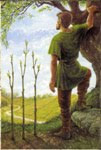Wei Bo was a very astonishing person and he worked with my mother developing a mathematical model of Aphid population in citrus. My mother and Dr Jon Allen were using the IBM personal computer in its very first generation and Wei Bo was writing programs in machine language since none existed to serve their purpose. Mom was her ever gregarious self and held to her firm belief that no one should be alone and certainly not lonely. So, Wei Bo became a common visitor at my house.
Once mom decided to give Wei Bo a great treat so she took him to dinner at Lei and Ping’s Chinese restaurant (Lei and Ping is another story entirely – Vietnamese boat people – my mom – it all fits together naturally, but it’s still a tale for another story) Mom was so excited to let Wei Bo experience some good home cooking. When the feasting was over, she asked him how he liked it. He smiled that slim smile which was all refugees from the Cultural Revolution could ever risk and said “this was very good – what kind of food is this?” Mom told him it was Chinese and Wei Bo stated “well, it is very good, but it is not Chinese”
Thus the tale was set for next Saturday when he and mom went to the store and bought many vegetables, a few spices, rice vinegar, tiny bits of meat and brought them all to our kitchen table where Wei Bo proceed to thinly slice and chop and prepare mounds of food. What all was made escapes our memories except for one stuffed dumpling dish we remember as “dragon” Dragon was delicious and it was crisp and brown and made entirely without oil.
I imagine the concept of oil free frying developed out of economics but develop it did and Wei Bo Chen was right there in our kitchen miraculously turning out crispy dumplings as fast as my family could eat them. Eventually Wei Bo had to return home to his family and mom parted with her dear friend. Wei Bo Chen and my mother stayed in touch for decades. Unfortunately, I think they have lost touch in the last few years but I can guarantee if Wei Bo still lives he would smile that timid little smile if he read this. My mother of course still loves him as she is want to do with anyone she ever cares about.
Well Wei Bo Chen is gone from the Hedley household but not all of him. We still know how to water fry. I propose to teach this truly simple method of cooking as a tribute to him and his love for my family. It is really simplicity itself. There are only a few key elements – timing is what is essential.
WATER FRYING
1) First, one can only do small batches at a time – do not crowd your skillet. If the items are touching to much they will sweat and not fry
2) Secondly, it will work best with food cut into Chinese style bit size bits
3) Get your skillet or pot very hot – at the high end of your cooking range
4) Keep a cup or two of water nearby. Add three tablespoons of vinegar (rice is nice) to each cup
5) Once the skillet is hot test it by sprinkling a few drops of water in it – they should immediately skitter around the pan and disappear into steam almost immediately. If they sit and bubble – it is not hot enough,
6) Once the pan is ready toss in your first batch of chicken let us say
7) At the same time the food hits the pan splash in a bit of the water
8) A few seconds after the first splash has flashed off into steam dash in another sprinkle
9) Keep this up – never allowing water to stand and moving the food to help prevent sticking
10) Keep flashing the food with water until it turns nice and golden brown
11) Remove first batch and continue with others if you have more to cook
You can use this technique to cook any food you would like to brown or crisp without using oil. You can also stir fry veggies using this method just don’t cook them as long and keep them wetter. The amount of vinegar is highly variable and depends on taste in large part. I have done it with no vinegar at all and also with more than half vinegar. The trick is keeping the pan scalding hot.
This truly is an heirloom skill and one which fits perfectly into simple living and frugal cooking on a small homestead. But more importantly it is a lesson taught with love across continents and across generations. I hope others learn it so it can cross time and remain a living tribute to Wei Bo Chen and his dear friend Lou Ellen.





